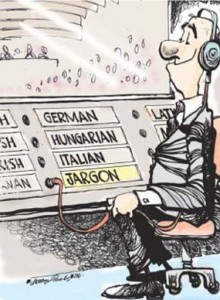
Whenever two or more people get together to achieve a common goal, it is common for the team members to develop a unique language of terms, expressions, words, and abbreviations that have been assigned and tailored to the effort.
The definition of the word “Jargon” is:
Jargon (jahr-guhn) – n
A specialized language concerned with a particular subject, culture, or profession
Every group I’ve joined – whether a civic, volunteer organization or as a member of a team of new product development engineers – has developed and used jargon in some way.
In my experience, jargon develops slowly over time as challenges are defined, issues are addressed, and development efforts take shape.
Jargon can be subtle, or it can be overt and very pervasive. For instance, I am a huge fan of NASA missions – I follow their progress often, yet I have often wondered whether NASA could get anything accomplished without applying jargon to their work.

In engineering, the use of jargon is very common. It can be very useful. And like most things, there are pros and cons.
Pros:
- Streamlines communication
- Exchanging complex information efficiently
- Making topics and principles more ‘visual’
- Compartmentalizing issues, concepts, components, etc.
Cons:
- The terms are often unintelligible to those outside the group that uses it.
- Long ramp for new members of the team
- Mistakes made in interpreting meaning
- Lack of common understanding
Here is a bit of the jargon and acronyms we use in the cash drawer biz:
| Jargon | Definition | Owner | Context / Meaning or Application |
|---|---|---|---|
| BOM | Bill of Material | Engineering and Manufacturing | A list of components developed in a MRP/ERP system that comprise a final item |
| CAR | Corrective Action Report | Quality Manager | A document used to capture and report issues and their resolution |
| DHF | Design History File | Engineering | A folder location on the server, that serves a project. A place to capture documents, revision history, notes, emails, and the like. |
| ECN | Engineering Change Notice | Engineering | A report that defines the scope of a product or component change, including effectiveness and justification |
| LEM | Latch Ejection Mechanism | Engineering | Typically the discrete assembly of components that serve capture and hold the cash drawer closed |
| NPS | New Product Specification | Product Management | A document that captures and conveys customer requirements – a key component of our quality management system |
Remember that customers, suppliers and other stakeholders may not understand your terminology once the topic leaves the work group or as new members join so definitions are crucial.
Define your jargon and your special terms and acronyms, so that others can come up to speed more quickly. Your definition should include the term, its definition, an ‘owner’ of the term, and the context in which it is most commonly used.
While the proper use of jargon can be an effective and efficient way of communicating within a work team, when left with inadequate context and definition, jargon can have a negative connotation when used excessively with individuals outside the immediate team.
Manage your efforts, improve communication, and share your experience more effectively by defining your jargon.

